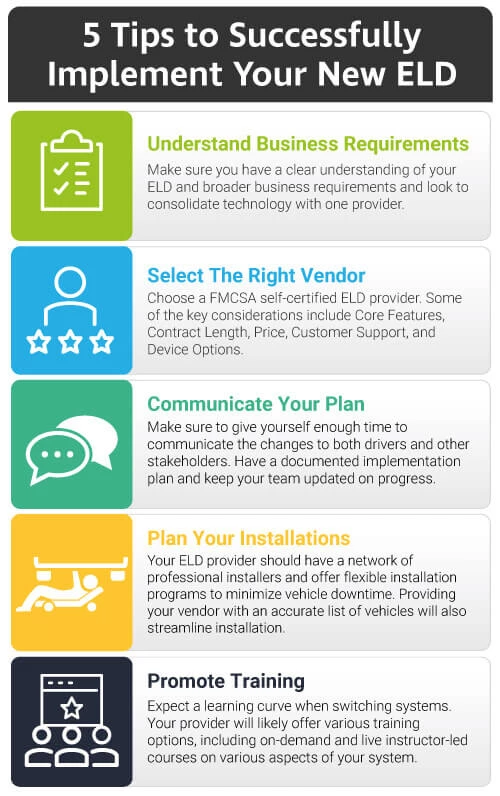Key Takeaways
The successful implementation of new ELD’s comes down to sourcing the right vendor and carefully planning the implementation. To make sure that you are getting maximum value from your ELD service, consider the wider fleet management needs beyond ELD and increase your return on investment by consolidating your fleet technology into one provider.
Whether you're switching providers or implementing the technology for the first time, installing ELD in your fleet requires planning and due diligence. But with the right provider, this process can be smooth with limited disruption.
There are many factors to consider when implementing an ELD device successfully. In addition to choosing the right product for your business, planning the implementation and employee training are two key areas companies should consider when evaluating suppliers and planning a switch. In this article, we will provide five tips to implement your ELD device successfully.
Top 5 Tips for ELD Implementation Success
Understand Your Requirements
Modern ELDs can do much more than track a driver’s hours of service (HOS). Before starting your journey toward choosing an ELD provider, it's important to fully understand your business requirements and what areas of your business you're looking to improve through technology. The key is knowing what data will help you improve fleet performance and whether there are processes that would benefit from automation and digitization. Some areas to consider are:
- Fuel tax (IFTA) reporting
- Driver communication
- Navigation and route optimization
- Dispatching
- Document management
- Third-party integrations
We would recommend conducting a needs analysis across your drivers, executives, and other stakeholders and develop a prioritized list of information you would like to capture and processes that you would like to digitize.
Select the Right Vendor
Once you've identified what you're looking for in an ELD, it's time to shop providers. There are a number of ELD providers to choose from, which makes selecting the right vendor somewhat challenging. There are several factors to consider when making that decision. But to help ensure compliance with federal laws, you should only consider FMCSA self-certified ELD providers. Here are some other key considerations:
- Core Features: No two ELD providers are alike. But all ELDs should include core features, such as hours of service (HOS), unassigned driver time management, and exception management.
- Contract length: With most ELD providers operating on a Software-as-a-Service (SaaS) model, the contract length is important in calculating the system's total cost. The typical contract length is two to three years, but some are as long as five years.
- Price: Price is always an important factor when evaluating new technology. Some ELD providers will charge for hardware and installation while others build those costs into the monthly fee. One way to improve price efficiency is to bundle other features your ELD provider may offer, such as safety analytics, dashcams, weather telematics, and more.
- Customer Support: One of the most important things to consider when evaluating an ELD provider is the level of customer support offered. Does the provider offer training and 24/7 support? Are there driver-specific support and learning options? What's the company's resolution record and does it have good online reviews?
- HOS Coverage Gaps: When switching from one vendor to the next businesses must stay compliant at all times. Implementation, training, and a go-live strategy are extremely important since there is no grace period or the ability to ever use paper logs.
- Device Options: Finally, what device options are available? This can range from professionally installed, hardwired devices to plug-and-play and beyond. Some providers offer a "bring your own device" (BYOD) program that's compatible on your driver's smartphone or tablet.
Communicate and Plan
Whether you have five trucks or 5,000, switching ELD providers requires communication and planning to be a success. Make sure to give yourself enough time to communicate the change to both drivers and other stakeholders.
Develop a roll-out strategy that includes overlap between the two providers to ensure a clean execution and additional learning time for anyone who will use the new system, specifically drivers. Document milestones to prevent timeline slippage and limit vehicle downtime.
Understand the Installation Process
Installation should be smooth and designed to limit vehicle downtime. With proper expectations and a clear understanding of everything involved, the installation process can be simple. Yes, installing a new ELD does require your vehicles to be offline, but downtime can be limited through planning. This is another area in which selecting the right ELD provider can have a considerable impact. Ensure your provider has a network of trusted professional installers and provide them with the time and space needed to complete the job. You will also want to give the ELD provider an accurate list of your vehicles, including year, make, and model, to ensure the right hardware and cabling are provided.
Make Time for Training
Lastly, training is key to ensure a successful ELD implementation. There is always a learning curve when switching systems. Your provider will likely offer various training options, including on-demand and live instructor-led courses on various aspects of your system. In addition to that, how-to articles and self-help videos may be available for the more straightforward tasks.

